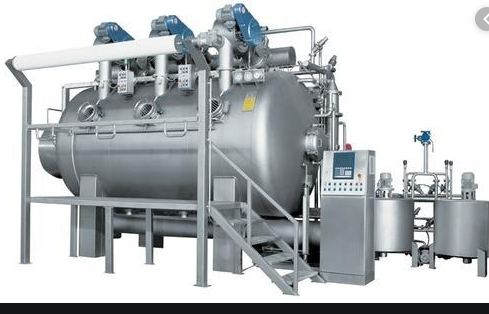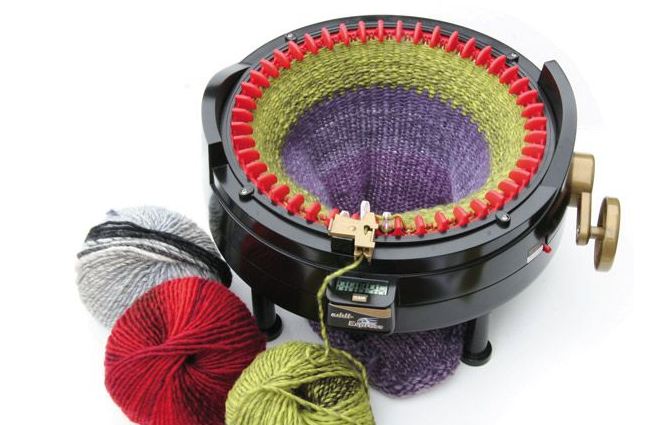PROCESS FOR LEVEL DYEING OF 100% COTTON KNIT FABRICS WITH REACTIVE DYE
CHOWDHURY JONY MOIN1 AND A.K.M. MAHABUBUZZAMAN2
1 Senior Lecturer, Department of Textile
Engineering, Southeast University, Dhaka, Bangladesh
and 2 Principal Scientific Officer,
Mechanical Processing Division, Bangladesh Jute
Research Institute (BJRI), Manik Mia Avenue, Dhaka-1207, Bangladesh.
Accepted for publication
on 17 July 2009
ABSTRACT
Moin, C.J., and Mahabubuzzaman, A.K.M. 2009. Process for level dyeing of 100% cotton knit fabrics with reactive dye.
J. innov.dev.strategy 3(4): 01- 08.
The research was carried out at Hamza Textile Mills Ltd.of Gazipur in 2007. A beige color is selected to dye in a modern knit-dyeing machine (jet type) with the capacity of 500kg; maximum load of 440kg with 88% load. Three batches are dyed and observed. The machine contains two separate feeding units and has the scope of dividing the batch into two parts, with 220 kg each. This study will enable the industry to reduce loss of reprocess and rejection of fabric. The study was identified that precision setup of cycle time, run-time, dosing time and temperature gradient can improve meter-to-meter variation from 66%- 86%; the study considers the factors namely water hardness, dyes combination and dyes levelling properties were optimum. In this study it was found that a satisfactory improvement in level dyeing of 100% cotton knit fabric with reactive dye could be ensured without additional chemicals or operational costs.
INTRODUCTION
Manufacturing of knit goods is cheap and 100% cotton knit
items are very comfortable which increase the
demand of knit underwear as well as outerwear. As a result knitting, knit dyeing and finishing industries are growing very
rapidly (Biljana et al 2004). In
2006, Textile Intelligence estimated yearly production of knitted goods to be 17 millions tons,
which is one-third of global textile market, and predicted an increase by 25% over the next 10 years,
amounting 21 millions
tons/year (Booth, 1968).
New fibre will be used and that will create new markets.
Designers will get high-tech fibres to create more sophisticated items, which will reduce monopolistic use of 100% cotton knitted textile in basic apparel.But still we are in trouble for quality of knit clothing items.
Day by day the customers are going to be more conscious about quality of clothing items. As a result it became more challenging to the manufacturer. First of all cotton
determines the quality of textile, hence higher quality cotton is used for clothing and lower quality for household or industrial products (Crown, 2005). If fibre is selected as per quality, then fabric quality will depend on fabric manufacturing and processing techniques.
Generally cotton fibres are ring spun to card, combed and compact yarn, among these first one is inferior and last one is the best in quality. The properties of yarn are directly shifted to the fabrics, as fabric- manufacturing techniques define arrangement of yarn by creating loops and interlacements. After fabric manufacturing the fabric is subjected for wet processing to add values.
Jets and Winch dyeing machines are usually used as exhaust equipment for preparation, dyeing and finishing of apparel knit fabrics (David, 2005). Knit fabric wet processing is started with batching or batch preparation where fabric is weighted as per machine capacity and the fabric is turned to inside out in case of body fabric i.e. main fabric of garments. Normally in Bangladesh single jersey fabric such as plain, locust, pique etc. fabrics are widely used for body fabric of garments. Interlock, rib, fleece fabrics are also turned to inside out when those are in unbalanced structures and used as body fabric of garments. The fabrics are usually turned to keep away from the any unaccepted incident or damage on face side and remove edge marks, which are created due to formation of fabric roll.
Background
Maximum knit fabric problems are created during preparation, dyeing and after treatment
process. Common problems of knit dyeing are edge mark, crease mark, pin hole, loss of fabric strength, shade variation of batch to batch, uneven dyeing (such as roll to roll shade variation, patchy, color spot, white spot, meter to meter shade variation), hand feel problem, fastness problems etc.
Edge mark and Crease mark
incase of edge mark fabric is turned before wet processing and for precaution gray fabric roll should not too tight and should not stored for a long time. For crease marks anti-creasing chemicals are used. However, to ensure perfect remedy, preventive measures are more convenient and prescribed. Among the precautionary measures followings are ensured like convenient machine speed (with fabric compactness), correct loading (no twisted rope and knots), relaxation of fabric; proper dyeing process (heating-cooling rates not too rapid). Simultaneously the measures like stationary fabric in a running machine, overloading which might cause mechanical frictions, rough patches in the machine, tight construction of fabric, high twisted yarns and high GSM are avoided. |
Pinhole
Pinhole is an interesting and very dangerous problem; it may cause rejection of full batch fabric. The reason behind this is presence of Fe+ and Cu+
ions in water and active per-oxide that is used during bleaching (Teal at
el, 2002). As there is no correction options water hardness should be
within limit or strong sequestering agent should be used and per-oxide killing
should be done properly.
Fabric strength
Contamination of sulphuric acid with acetic
acid, longer process
with excess scouring
bleaching chemicals, delay of killing the enzymes, very high
speed of machine, too long dyeing (corrective or repairing) process are mainly responsible for loss of fabric strength
(Teal at el, 2002).
Shade variation batch to batch
Consistency of dyeing performance mainly depends on minimum shade variation of batch to batch. Process parameters such as water hardness, M:L, time, temperature, recipe,
reproducibility of dyes, dye lot, fabric structure, GSM, fibre lot, yarn count etc. should
be same as much as possible for minimizing batch to batch
shade variation problem.
Roll to roll shade variation and Patchy
Roll to roll shade variation always confused for matching the batch with standard shade and produces a variety of shade within a batch. This is a result of mixing of fabric roll produced from different fibre lot, yarn count, GSM, structure and even sometime for different machines. So to avoid such problems one has to avoid mixing of different types of fabrics. Patchy is the real uneven dyeing; this may result of uneven absorbency, electrolytes (salt) alkaline pH, uneven and sudden alkali dosing, wrong dye combinations, improper mixing of dyes, improper neutralization after scouring-bleaching and dyeing, fabric entanglement during process etc. If above mentioned points are under controlled then possibility of patchy is very low.
Color spot and White
specks
Color spot is the result of improper color mixing (very serious issue in case of turquoise dyes as their dye molecules are comparatively larger), water hardness and presence
of heavy metal sulphate, sulphides, sulphites & alkali especially caustic soda. Water treatment plant (WTP), sequestering agent and proper mixing of dyes are fundamental solution of this problem. White specks are mainly yarn problem i.e. dead or immature
fibres. Moreover contamination in water, improper dissolve of alkali and presence of silica based chemical before dyeing also arise white spots. Excluding yarn quality; WTP, proper handling of caustic and de-finishing removing silica based finishes, incase processing of finished fabric with such finishing chemicals, are necessary to solve such problem.
Meter to meter shade variation
Meter to meter shade variation is a typical shade variation problem. Very short dyeing
arise unleveled dyeing (Gordon, 2006) .United State patent 4,629,465 and 5,167,668 show that level dyeing is dependent on controlled addition of dyes and electrolytes and proper alkali dosing system for dye fixation respectively. Another United State patent 4089644 suggested controlling the rate of dye adsorption of dye on to the substrates by the number of cycles of dye liquor and/or substrates throughout the dyeing process.
Furthermore, during my job in the industry, it was found that, imbalance dosing time, run time and temperature gradient of each step with cycle time of fabric is responsible for meter-to-meter shade variation. Six batches are dyed with linear dosing system, incase of
alkali & per-oxide dosing of scouring- bleaching and dyes, salt, alkali of dyeing,
on this aspect and described in methodology and result section.
Hand feel and Fuzzy appearance
Hand feel problem is irreversible due to use of harsh metal chemicals for processing. It can be easily reduce by demineralization and can improve by the addition of softener. Fuzzy appearance comes because of fabric to fabric, fabric to chemicals and fabric to machine abrasion in presence of high temperature for a long period of time. Nowadays very popular bio polishing is practiced to improve the appearance of the fabric.
Fastness problems
Fastness problems are result of improper washing off, presence of unfix dyes, hydrolysis of dyes, dyeing with excessive dyes, poor fastness properties of dyes, improper use of fixer and softener
(
Process for level dyeing of 100% cotton knit fabrics with reactive dye
METHODOLOGY
A beige color is selected to dye in a modern knit-dyeing machine (jet type) with the capacity of 500kg; maximum load of 440kg with 88% load. Three batches are dyed and
observed. The machine contains two separate feeding units and has the scope of dividing
the batch into two parts, with 220 kg each.
Traditionally in our country technicians are habituated
for maintaining the cycle time in between 2.5 to 3 minutes as standard.
First batch is dyed with 3 minutes cycle time. The secondone is dyed with 3 minutes cycle time and synchronized to chemicals & dyes dosing time and runtime. And the third batch dyed with a cycle time of 2.5 minutes where chemicals & dyes dosing
time, run time and temperature gradients are synchronized with cycle time. Full fabrics
are inspected for meter-to-meter shade variation and ten samples are taken randomly
for each batch. Ten samples from each batch are catalogued along each other and inspected visually. Finally 3 batches are examined to identify the extent of meter-to-meter shade variation among the batches.
Furthermore, samples are measured in a spectrophotometer for each batch considering the sample-1 as standard and other nines as batches. Data for each batch are analyzed with respect to dE. And then statistical analysis is done to identify the improvements in levelness of dyeing between three batches.
Additionally, three batches of another color (Brown) are also dyed and inspected maintaining the same procedure of beige color.
RESULT AND DISCUSSION
For both color it is clearly observed that third batch
gives the most level dyeing and second batch gives more than the first. The reason behind these is for third batch cycle time is synchronized to dyes and chemicals dosing time, temperature gradient and run time where as at second batch cycle time is synchronized to dyes and chemicals dosing time and run time. Here cycle time means the time required for the fabric to complete one revolution.
Theoretically for uniform dyeing adsorption, absorption and fixation should be uniform. This study focused on these factors and made following adjustments (a – e as shown in Annexture-1 Table 1). a) Scouring- bleaching process determines uniform absorption properties. To get uniform absorption properties dosing time (DT) of caustic and per-oxide set in such a way that during dosing fabric can complete it’s full cycles
i.e. DT/CT= an integer. For example, in second batch
it was six minutes (6/3=2) and five minutes (5/2.5=2) for third batch.
b) Incase of scouring-bleaching run time for 2nd and 3rd batches it was 60 minutes where run time (RT) also perfect for completion of fabric cycles i.e. RT/CT== a integer (60/3=20 & 60/2.5=24). So during run time 2nd batch complete 20 cycles and 3rd batch 24 cycles. c) Similarly, salt dosing time 21 minutes for 2nd batch and 20 minutes for 3rd batch. Dyes and alkali dosing time also 30 minutes and 60 minutes, both are compatible for completion of full cycles of fabric. These DT ensures the uniform impregnation of fabric during DT, hence ensures level adsorption, absorption and fixation.d) According to b run times are also set to 51 and 50 minutes for 2nd and 3rd batch respectively. These RT
ensures the uniform impregnation of fabric during RT, hence ensures level adsorption, absorption and fixation.
e) For third batch another factor; temperature gradient (TG) for scouring-bleaching is also synchronized with cycle time. Room temperature was 38oC. The scouring-bleaching temperature was 110oC. So temperature is increased by 72oC. The temperature gradient in 3rd batch was 3oC/minute and total time required to raise temperature up to 110oC was 72/3 = 24 minutes. Within this 24 minutes fabric completed 9.6 cycles ≈ 10 cycles {24 minutes/2.5 minutes (CT) = 9.6}. So this ensures uniform absorption properties of fabric as with the increase of temperature the action of caustic and per-oxide increase rapidly.
Another factor also noticeable that batch-3 received more impregnations of fabric (due to less cycles time, 2.5 minutes) than batch-2; this more impregnation also helps to improve level dyeing. With respect to the sample 1, dE value of the rest nine samples from respective
batches, are measured by spectrophotometer. Annexture-1 Table 2 shows the dE value of beige colour and its three batches against sample 1 of corresponding batches. Similarly, Annexture-1 Table 3 shows the dE value of brown colour and its three batches against sample 1 of corresponding batches. Variance of dE which represents variance of 9 samples for each batch.
For beige colour, batch 1 shows variance of dE as 0.152. After the adjustment of the process (as mentioned in Annexture-1 Table 1), in Batch 2 and 3, variances of dE are found 0.051 and 0.021 respectively. Consequently, batch 2 and 3 shows 66.45% and 86.18% improvement against batch 1 (Annexture-1 Table 4). In case of brown colour,
batch 1 shows variance of dE as 0.075. After the adjustment of the process (as mentioned in Annexture-1 Table 1), in Batch 2 and 3, variances of dE are found 0.020 and 0.010 respectively. Consequently, batch 2 and 3 show 73.33% and 86.67% improvement against batch 1
(Annexture-1 Table 4).
CONCLUSION
The study found that a satisfactory improvement in level
dyeing of 100% cotton knit fabric with reactive dye could be ensured without additional chemicals or operational
costs. Suggested adjustments are much user-friendly as well. This study will enable the industry to reduce loss of reprocess and rejection of fabric.
REFERENCES
Biljana,
M., Goran D. and Igor J. 2004. Structural characteristics of cotton knitted
fabrics after enzymatic
and alkaline scouring,
Bulletin of the chemists and technologists of Macedonia, vol. 23 No. 1, pp. 19-28.
Booth, J.E. 1968. Principles
of Textile Testing,
Butterwrth Heinemann Ltd. UK. 0-592-06325-9, P 101.
Crown, J. 2005. Critical
solutions in the dyeing of cotton. Textile
progress, The Textile
Institute.Dec., P- 150.
David,
T. Parkes, 2005. Dye house productivity Back to basics.
Istanbul Conference, May pp-15-21.
Gordon, R. 2006. The preparation, dyeing and finishing of
cotton knit goods. Nearchimica S.p.A. textile
auxiliaries. P-22.
Teal, S, R.T.Ervin
and R.D. Mehta, 2002. Economic
analysis of cotton textile finishing
processes, Part 2- After treatments, Texas Tech University, Lubbock, Texas, USA pp-15-20.
www.researchandmarkets.com/reports/29475/world_markets_for_knitted_textiles_and.pdf.
ANNEXTURE-1





